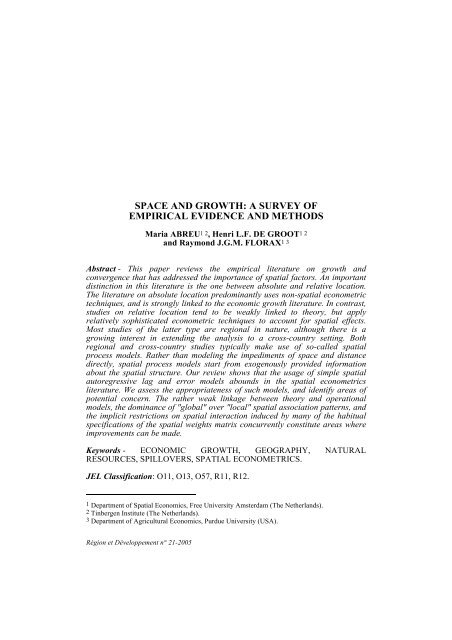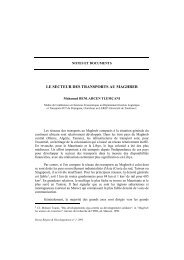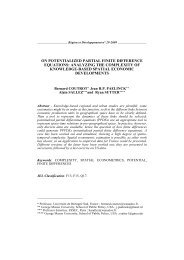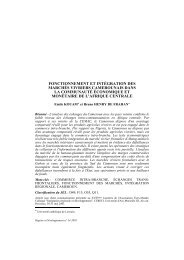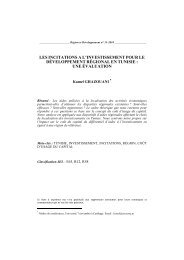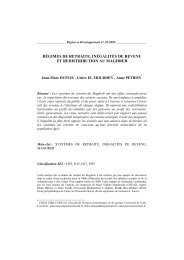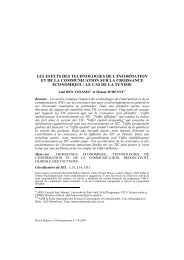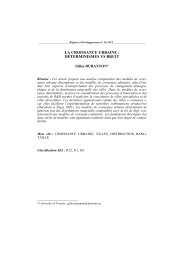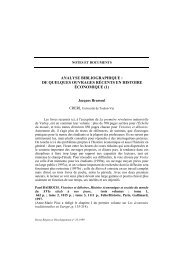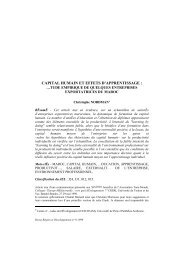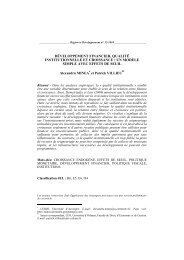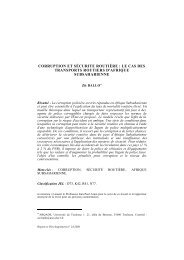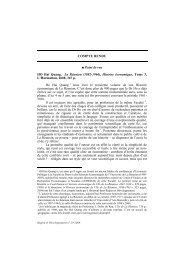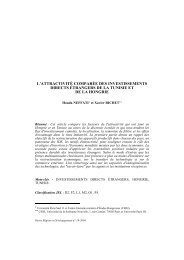space and growth: a survey of empirical evidence ... - ResearchGate
space and growth: a survey of empirical evidence ... - ResearchGate
space and growth: a survey of empirical evidence ... - ResearchGate
You also want an ePaper? Increase the reach of your titles
YUMPU automatically turns print PDFs into web optimized ePapers that Google loves.
14 Maria Abreu, Henri L.F. de Groot <strong>and</strong> Raymond J.G.M. Florax1. INTRODUCTIONThe possibility that <strong>space</strong> is a determinant <strong>of</strong> economic <strong>growth</strong> has beenconsidered in several <strong>empirical</strong> studies, mostly in the context <strong>of</strong> geographicalvariables such as latitude, climate <strong>and</strong> topology (e.g., Gallup et al., 1999).Recently, the possibility has also been explored in the spatial econometricsliterature, a sub-field <strong>of</strong> econometrics dedicated to the study <strong>of</strong> spatial interaction<strong>and</strong> spatial structure (Anselin, 2001). Our aim in this article is to review the<strong>empirical</strong> literature on <strong>growth</strong> <strong>and</strong> <strong>space</strong>, starting with studies that incorporategeography into st<strong>and</strong>ard models <strong>of</strong> <strong>growth</strong>, <strong>and</strong> moving on to more complexmodels <strong>of</strong> spatial interaction. We critically assess the contribution <strong>of</strong> spatialeconometrics to the study <strong>of</strong> <strong>growth</strong> in light <strong>of</strong> the broader <strong>empirical</strong> literature,<strong>and</strong> suggest directions for further research.Previous <strong>survey</strong>s <strong>of</strong> the <strong>empirical</strong> <strong>growth</strong> literature have tended to avoidthe topic <strong>of</strong> <strong>space</strong>, with some exceptions. Durlauf <strong>and</strong> Quah (1999) <strong>and</strong> De laFuente (1997) discuss it in the context <strong>of</strong> human capital spillovers <strong>and</strong>technology diffusion. However, in these models countries differ only in theirlevels <strong>of</strong> human capital vis-à-vis the world average, <strong>and</strong> location plays no role indetermining the extent <strong>of</strong> spillovers. It is acknowledged that <strong>space</strong> mustinfluence the channels through which countries interact, but these channels arenot modeled explicitly. Durlauf <strong>and</strong> Quah (1999) also mention a number <strong>of</strong>geography studies as part <strong>of</strong> a list <strong>of</strong> recent <strong>empirical</strong> contributions, but do notdiscuss them in detail.Temple (1999) briefly discusses the possibility that disturbances in <strong>growth</strong>regressions may be correlated over <strong>space</strong>, due to omitted variables with a spatialdimension such as climate, institutions <strong>and</strong> technology. As a possible solution hesuggests including country dummies as proxies for these variables. Islam (2003),focusing mainly on convergence studies, also discusses the consequences <strong>of</strong>omitting variables from the st<strong>and</strong>ard <strong>growth</strong> regression, <strong>and</strong> proposes using apanel data model with country fixed effects. He also considers the possibilitythat other parameters might vary across countries, <strong>and</strong> refers to Lee et al. (1997)in connection with this problem. These are all examples <strong>of</strong> approachesaddressing spatial heterogeneity, the notion that parameters in <strong>growth</strong> modelsmay vary across <strong>space</strong>.Most <strong>of</strong> the research on <strong>growth</strong> in the spatial econometric literature hasbeen carried out using regional data, possibly because spatial econometrics hastraditionally been used in regional science applications, <strong>and</strong> many regionalscientists are familiar with the techniques. This familiarity is also reflected in<strong>survey</strong>s <strong>of</strong> regional <strong>growth</strong>, where spatial econometrics is mentioned explicitly.Rey <strong>and</strong> Janikas (2005) review the literature on regional convergence, with a
16 Maria Abreu, Henri L.F. de Groot <strong>and</strong> Raymond J.G.M. Floraxomission <strong>of</strong> variables with a spatial dimension such as climate, latitude <strong>and</strong>topology. Moreover, the spatial econometrics literature might gain from delvingmore deeply into the policy <strong>and</strong> theoretical implications <strong>of</strong> their results. On theother h<strong>and</strong>, the non-spatial econometrics literature would do well to adopt themore rigorous approach to testing, modeling <strong>and</strong> visualization <strong>of</strong> the resultsdeveloped in spatial econometrics. The residuals <strong>of</strong> mainstream models shouldbe tested for spatial dependence, since ignoring it could result in serious modelmisspecification.The rest <strong>of</strong> our article is organized as follows. In Section 2, we review thetreatment <strong>of</strong> <strong>space</strong> in the non-spatial econometric <strong>and</strong> the spatial econometricliteratures, <strong>and</strong> discuss the distinction between models <strong>of</strong> absolute <strong>and</strong> relativelocation. In Section 3, we discuss several unresolved issues in the application <strong>of</strong>spatial econometrics to the study <strong>of</strong> economic <strong>growth</strong>. In Section 4, we discussdirections for further research <strong>and</strong> conclude.2. AN OVERVIEW OF THE LITERATUREThis section provides a global overview <strong>of</strong> the <strong>empirical</strong> literature that hasinvestigated the role <strong>of</strong> <strong>space</strong> in explaining variation in economic <strong>growth</strong>. Inorder to facilitate the discussion, we divide the literature into studies thatexplicitly apply spatial econometric techniques <strong>and</strong> those that do not. The formerare predominantly concerned with relative location, while the latter focus onabsolute location. A more detailed classification with brief descriptions <strong>and</strong>examples can be found in Table 1.2.1. Space in the non-spatial econometrics literatureThe non-spatial econometrics literature has largely focused on models <strong>of</strong>absolute location, <strong>and</strong> the studies therefore (implicitly) focus on spatialheterogeneity. The notion <strong>of</strong> spatial heterogeneity that we consider here isbroader than the one typically used in the spatial econometrics literature, whichis tightly linked to the concept <strong>of</strong> spatial regimes1.In models that apply spatial regimes, the parameters are allowed to varyacross groups <strong>of</strong> countries or regions (the regimes), <strong>and</strong> <strong>of</strong>tentimes groupwiseheteroscedasticity is also allowed. Our argument is that while spatial regimes isan extreme form <strong>of</strong> spatial heterogeneity, incorporating spatial variables directlyinto the regression also takes account <strong>of</strong> spatial heterogeneity, albeit on a moregradual <strong>and</strong> refined scale.1 By spatial regimes we mean models in which the sample is divided into groups according to thevalues taken by a variable with a spatial dimension, for example North <strong>and</strong> South (according tolatitude), or tropical, subtropical <strong>and</strong> temperate (according to climate zone).
Région et Développement 17Table n° 1: Classification <strong>of</strong> studiesABSOLUTE LOCATIONChannel Effect on <strong>growth</strong> Measures ExamplesDiseaseAgriculturePolicyInstitutionsTradeSpatial heterogeneityIncidence <strong>of</strong> malaria <strong>and</strong>other diseases has ageographical dimension.Agricultural productiondepends on soil quality,topology <strong>and</strong> climate.Technology developed intemperate climates is notsuitable for tropicalclimates.Abundance <strong>of</strong> naturalresources discouragesindustrial production <strong>and</strong>results in rent-seeking.Natural openness reducescorruption.Long-run view.Institutions are a result <strong>of</strong>initial conditions(climate, location, naturalresource abundance).Natural opennessencourages trade, lowerscorruption <strong>and</strong> allowsaccess to foreigntechnology.Parameters in <strong>growth</strong>models differ acrosseconomies. Countries <strong>and</strong>regions are converging todifferent steady states.Climate zone, latitude,average temperature.Climate zone, soil type,average days <strong>of</strong> winterfrost.Mineral wealth,l<strong>and</strong>locked dummy,natural obstacles.Climate zone, ecologicaldiversity, latitude,l<strong>and</strong>locked dummy,natural obstacles, l<strong>and</strong>mass.L<strong>and</strong>locked dummy,distance to the coast,navigable rivers, naturalobstacles, l<strong>and</strong> mass.Latitude, climate zone,regional dummies.Bloom <strong>and</strong> Sachs(1998), Gallup <strong>and</strong>Sachs (2001), McArthur<strong>and</strong> Sachs (2001).Gallup <strong>and</strong> Sachs(2000), Sachs (2000),Masters <strong>and</strong> McMillan(2001).Gallup et al. (1999),Wei (2000).Diamond (1997), Hall<strong>and</strong> Jones (1999),Acemoglu et al. (2001),Rodrik et al. (2002),Easterly <strong>and</strong> Levine(2003).Sachs <strong>and</strong> Warner(1997), Frankel <strong>and</strong>Romer (1999).Barro (1991), Armstrong(1995), Biv<strong>and</strong> <strong>and</strong>Brunstad (2002),Baumont et al. (2003),Roberts (2004).RELATIVE LOCATIONChannel Effect on <strong>growth</strong> Measures ExamplesTechnology diffusionSpilloversSpatial convergence clubsSt<strong>and</strong>ard spatialeconometric analysisThe rate <strong>of</strong> technologydiffusion depends ondistance to thetechnology leaders.Political, social <strong>and</strong>economic factors inneighbouring countriescan have an impact on<strong>growth</strong>.Countries <strong>and</strong> regions areconverging withingroups.Exploratory spatial dataanalysis, LISA, spatiallag <strong>and</strong> spatial errormodels, cross-regressiveterm, spatial regimes.Geographical distance,cultural distance,transport costs.Contiguity, length <strong>of</strong> theborder, geographicaldistance.Contiguity, geographicaldistance, culturaldistance.Contiguity, geographicaldistance, nearestneighbors, spheres <strong>of</strong>influence.Coe <strong>and</strong> Helpman(1995), Coe et al.(1997), Keller (2002),López-Bazo et al.(2004).Ades <strong>and</strong> Chua (1997),Easterly <strong>and</strong> Levine(1998), Murdoch <strong>and</strong>S<strong>and</strong>ler (2002), Lall <strong>and</strong>Yilmaz (2001).Baumont et al. (2003),Carrington (2003),Ramajo et al. (2003).Moreno <strong>and</strong> Trehan(1997), Rey <strong>and</strong>Montouri (1999), LeGallo et al. (2003).
18 Maria Abreu, Henri L.F. de Groot <strong>and</strong> Raymond J.G.M. FloraxAlthough the bulk <strong>of</strong> this section will be concerned with models <strong>of</strong>absolute location, there are a few studies in the non-spatial econometricsliterature that deal with relative location, notably studies <strong>of</strong> spillovers <strong>and</strong>technology diffusion. We conclude this section by discussing their significance,<strong>and</strong> how they relate to the spatial dependence models typically estimated in thespatial econometrics literature that will be reviewed in Section 2.2.Within the literature using models <strong>of</strong> absolute location there are somestudies that incorporate geographical variables directly into the analysis, so that<strong>growth</strong> is a function <strong>of</strong> variables that are invariant over time <strong>and</strong> thereforeexogenous (since they precede economic <strong>growth</strong> <strong>and</strong> development). Typicalexamples are Hall <strong>and</strong> Jones (1996), Sachs <strong>and</strong> Warner (1997) <strong>and</strong> Lee et al.(1997), who find that latitude is a negative determinant <strong>of</strong> <strong>growth</strong>, aftercontrolling for other social, political <strong>and</strong> economic factors.Another part <strong>of</strong> the literature deals with the indirect effects <strong>of</strong> geographythrough different channels. The idea is that geographical variables can be used asinstruments for other variables that have a direct effect on <strong>growth</strong>. Onehypothesis linking absolute location with <strong>growth</strong> emphasizes the higherincidence <strong>of</strong> infectious diseases in the tropics. Among them, malaria is unique inthat it is not a consequence <strong>of</strong> poverty, <strong>and</strong> the feasibility <strong>of</strong> eradicating it ismainly determined by climate <strong>and</strong> ecology. This allows the authors to either treatit as exogenous, or to instrument it using geographical variables. Bloom <strong>and</strong>Sachs (1998) <strong>and</strong> Gallup <strong>and</strong> Sachs (2001) find that the incidence <strong>of</strong> malaria hasa negative effect on economic <strong>growth</strong>, after controlling for other variablesrelated to policy, human capital <strong>and</strong> general health.A related channel through which geography can have an impact on <strong>growth</strong>is agriculture. Agricultural productivity in the tropics is low because tropicalsoils are poor in nutrients (winter frost is essential for creating a rich topsoil) <strong>and</strong>susceptible to erosion, rainfall is variable, <strong>and</strong> pests <strong>and</strong> diseases are widespread(again due to the lack <strong>of</strong> winter frost). In addition, only a small amount <strong>of</strong>agricultural research is carried out with tropical agriculture in mind, <strong>and</strong> whilemachines <strong>and</strong> other equipment can be used across climate zones, new cropvarieties need to be adapted to tropical climates. Gallup <strong>and</strong> Sachs (2000) findthat agricultural productivity <strong>growth</strong> is substantially lower in the tropics, whileMasters <strong>and</strong> McMillan (2001) show that <strong>growth</strong> increases sharply with thenumber <strong>of</strong> days <strong>of</strong> winter frost, particularly at low levels <strong>of</strong> frost.The relationships found in the literature on geography <strong>and</strong> <strong>growth</strong> have ledto a debate on the relative merits <strong>of</strong> geography, policy <strong>and</strong> institutions inexplaining long-run <strong>growth</strong>. It has been argued that the quality <strong>of</strong> institutions <strong>and</strong>policy may be affected by geographical <strong>and</strong> climatic conditions. For example,Acemoglu et al. (2001) argue that settler mortality rates in the European coloniesdetermined whether or not the colony became an extractive state with weak
Région et Développement 19institutions, which persisted to this day <strong>and</strong> affect economic performance. Theyfind that property rights, instrumented using settler mortality rates, have apositive effect on current GDP per capita. The result holds after controlling forthe current disease burden, <strong>and</strong> adding other geographical <strong>and</strong> social variables.Diamond (1997) also argues that geography <strong>and</strong> natural endowments can havelong-term effects on <strong>growth</strong> rates <strong>and</strong> income levels. Using his model, Hibbs <strong>and</strong>Olsson (2004) show that the variety <strong>of</strong> native plants <strong>and</strong> animals, the size <strong>of</strong> thel<strong>and</strong> mass, <strong>and</strong> the orientation with respect to the Earth's axis can explaindifferences in current GDP per capita.Regarding the relative merits <strong>of</strong> geography <strong>and</strong> institutions, Hall <strong>and</strong> Jones(1999), Easterly <strong>and</strong> Levine (2003) <strong>and</strong> Rodrik et al. (2002) find that geographyhas no effect on income per capita after controlling for its effect throughinstitutions. Easterly <strong>and</strong> Levine (2003) also find that policy variables have noimpact on development after geography <strong>and</strong> institutions have been accountedfor. This finding contradicts Gallup et al. (1999) <strong>and</strong> Wei (2000) who argue thatgeography can affect policy by altering the trade-<strong>of</strong>fs faced by the government,particularly when it comes to trade policy. On a similar note, Frankel <strong>and</strong> Romer(1999) show that trade, instrumented using geography variables, has a positiveeffect on income per capita.The relationships reviewed so far correspond to a weak form <strong>of</strong> spatialheterogeneity, where variables with a spatial dimension have been includeddirectly in the regression. A stricter concept <strong>of</strong> spatial heterogeneity is that usedin spatial econometrics, where it refers to parameter instability in <strong>growth</strong> models.A simple example is the inclusion <strong>of</strong> continent dummies into a st<strong>and</strong>ard <strong>growth</strong>regression to control for differences in omitted variables. The idea is thatcountries within continents are similar to each other in terms <strong>of</strong> variables such asclimate, culture <strong>and</strong> technology. Barro (1991) includes Africa <strong>and</strong> Latin Americadummies as explanatory variables in a <strong>growth</strong> regression, <strong>and</strong> finds that bothvariables have a negative coefficient. Similarly, Armstrong (1995) finds thatcountry dummies are jointly significant in a conditional convergence model forthe regions <strong>of</strong> the European Union. Allowing the intercept to differ acrosscountries or regions is another way <strong>of</strong> accounting for omitted variables, whichwould otherwise be part <strong>of</strong> the error term. For example, Islam (1995) <strong>and</strong> Caselliet al. (1996) estimate fixed effects models in order to avoid the possibility <strong>of</strong>omitted variable bias resulting from unobservable differences in technologylevels across countries. Similarly, Durlauf <strong>and</strong> Johnson (1995) allow groups <strong>of</strong>countries to follow different linear <strong>growth</strong> models, depending on their initialconditions.We now come to the studies within the non-spatial econometrics literaturethat focus on relative location. As we have mentioned before, they are in theminority, <strong>and</strong> mostly deal with technology diffusion <strong>and</strong> cross-countryspillovers. The technology diffusion literature starts with Coe <strong>and</strong> Helpman
20 Maria Abreu, Henri L.F. de Groot <strong>and</strong> Raymond J.G.M. Florax(1995), who argue that productivity is a function <strong>of</strong> both domestic <strong>and</strong> foreignR&D, with the latter spilling over through trade. Focusing on the 22 OECDcountries that conduct the bulk <strong>of</strong> the world's R&D, the authors constructmeasures <strong>of</strong> the domestic R&D stock using accumulated R&D expenditures, <strong>and</strong>measures <strong>of</strong> the foreign R&D stock using trade-weighted measures <strong>of</strong> the R&Dstocks <strong>of</strong> each country's trade partners. In this way the authors give more weightto R&D spillovers from countries that are located relatively close in terms <strong>of</strong>bilateral trade (<strong>and</strong> indirectly in terms <strong>of</strong> physical distance, since trade is afunction <strong>of</strong> physical distance). The results indicate that R&D spillovers aresubstantial. In a follow up to this paper, Coe et al. (1997) extend the analysis tostudy R&D spillovers from the OECD countries to a large number <strong>of</strong> lessdevelopedcountries. The results indicate that R&D spillovers from industrializedcountries to less-developed countries are substantial. Keller (2002) alsoexamines the effect <strong>of</strong> foreign R&D on domestic productivity, using data disaggregatedby industry for a sample <strong>of</strong> OECD countries. In order to test whethertechnology diffusion is local or global in scope, the foreign R&D term in themodel is weighted by an exponential distance decay function. Estimation resultsconfirm that technology spillovers are declining with physical distance. Theresults also indicate that sharing a common language facilitates technologydiffusion, <strong>and</strong> that technology spillovers are becoming less localized over time.Other studies <strong>of</strong> spillovers within the non-spatial econometrics literaturehave mostly focused on the effects <strong>of</strong> political instability in neighboringcountries. Ades <strong>and</strong> Chua (1997) find that regional instability (defined as theaverage number <strong>of</strong> coups <strong>and</strong> revolutions in neighboring countries) has a negativeeffect on <strong>growth</strong>. Murdoch <strong>and</strong> S<strong>and</strong>ler (2004) find that a civil war within adistance <strong>of</strong> 800 km can have a negative effect on <strong>growth</strong>.One advantage <strong>of</strong> using spatial econometrics to estimate models <strong>of</strong>technology diffusion <strong>and</strong> spillovers is that spatial relationships are summarizedin a spatial weights matrix. This allows the estimation <strong>of</strong> more complex models<strong>of</strong> spatial heterogeneity <strong>and</strong> spatial dependence. However, there is also a relateddisadvantage, which is that the spatial weights matrix (<strong>and</strong> by extension therelationships between countries) must be exogenous <strong>and</strong> in cross-section modelsit should be invariant over time. This precludes using trade, foreign directinvestment or measures <strong>of</strong> cultural distance as spatial weights. One possiblesolution could be the use <strong>of</strong> geostatistical models (discussed in Section 3), butmost studies <strong>of</strong> <strong>growth</strong> using spatial econometrics have focused on physicaldistance as a measure <strong>of</strong> the strength <strong>of</strong> bilateral ties. Interestingly, Keller (2002)uses physical distance to capture bilateral ties in order to avoid focusing on onechannel <strong>of</strong> technology diffusion. Trade, foreign direct investment, <strong>and</strong> contactsbetween researchers have all been shown to be a function <strong>of</strong> physical distance inthe <strong>empirical</strong> literature. There may thus be an additional methodological reasonfor focusing on bilateral relationships measured in terms <strong>of</strong> physical distance.
Région et Développement 212.2. Spatial econometrics <strong>and</strong> <strong>growth</strong>We now turn to the literature within spatial econometrics that has studiedthe impact <strong>of</strong> <strong>space</strong> on economic <strong>growth</strong>. In order to analyze the type <strong>of</strong> methods<strong>and</strong> techniques that have been used within this literature, we have compiled a list<strong>of</strong> all the spatial econometrics studies on <strong>growth</strong> (both published <strong>and</strong>unpublished) that could be found using search engines <strong>and</strong> publication databases(EconLit, SSRN, Econpapers, IDEAS). The studies are listed in chronologicalorder in Table n° 2. We have included each study only once; if a study has beenpublished we no longer consider the original working paper.Figure n° 1 shows the chronological distribution <strong>of</strong> studies. Over time, thenumber <strong>of</strong> published <strong>and</strong> unpublished papers increases exponentially, indicatinga rising interest in applying spatial econometric techniques to the study <strong>of</strong><strong>growth</strong>. It is also interesting to see the geographical scope <strong>of</strong> the studies. Interms <strong>of</strong> the countries or regions covered by the data, 68% <strong>of</strong> all studies useEuropean data (at various levels <strong>of</strong> aggregation). The second largest category iscomprised by studies that use country data from all continents, 11%. Thegeographical origin <strong>of</strong> the remaining studies is the US <strong>and</strong> Canada (8%), LatinAmerica (6%), Asia (5%), <strong>and</strong> a combination <strong>of</strong> the above (2%).Figure n°1: Chronological distribution <strong>of</strong> studies2520Number <strong>of</strong> studies1510501995 1996 1997 1998 1999 2000 2001 2002 2003 2004*Year* Forecast for 2004 calculated using observations from January-August 2004.A classification <strong>of</strong> the studies according to the channel through whichlocation affects <strong>growth</strong> reveals that the vast majority <strong>of</strong> the studies (63%) fallinto the st<strong>and</strong>ard spatial econometrics category (viz., they follow st<strong>and</strong>ard spatialeconometric procedures, <strong>and</strong> the emphasis is on methodology rather than on
22 Maria Abreu, Henri L.F. de Groot <strong>and</strong> Raymond J.G.M. Floraxtheory or policy considerations). Of these studies, 11% use spatial data analysistechniques, 6% use a spatial lag model, 29% estimate a combination <strong>of</strong> thespatial error, spatial lag, spatial cross-regressive <strong>and</strong> spatial regimes models,11% look at Markov transition matrices, <strong>and</strong> 6% use other more unusual types <strong>of</strong>models. The distribution <strong>of</strong> the remaining studies by type <strong>of</strong> channel is almostevenly split among four categories: 8% <strong>of</strong> the studies have focused on spatialheterogeneity, 11% on technology diffusion, 10% on spatial spillovers <strong>and</strong> 8%on spatial convergence clubs. The statistics also indicate that 8% <strong>of</strong> the studiesare based on models <strong>of</strong> absolute location, <strong>and</strong> 92% on models <strong>of</strong> relativelocation. Only 11% <strong>of</strong> all studies derive their <strong>empirical</strong> models explicitly fromtheory.All <strong>of</strong> the studies based on absolute location use a spatial regimes model toinvestigate spatial heterogeneity. Most <strong>of</strong> them also touch on spatial dependence,either by using exploratory spatial data analysis techniques to identify clusters,testing the residuals for autocorrelation, or estimating a spatial regimes modelthat also allows for spatial dependence. One <strong>of</strong> the advantages <strong>of</strong> using spatialeconometrics to estimate models <strong>of</strong> spatial heterogeneity resides in thepossibility <strong>of</strong> testing for any remaining spatial autocorrelation, since ignoring itcould result in biased coefficients. Another advantage <strong>of</strong> using spatialeconometrics is that exploratory spatial data techniques can help with theidentification <strong>of</strong> the spatial regimes. For example, Roberts (2004) estimates anabsolute convergence model using county-level data for the United Kingdom. Hefinds no <strong>evidence</strong> <strong>of</strong> convergence, <strong>and</strong> a test for parameter stability across thetraditional North-South divide is inconclusive. An exploratory spatial dataanalysis reveals a cluster <strong>of</strong> counties in the South West with low initial levels <strong>of</strong>GDP per capita. A spatial regimes model based on a structural break between theSouth West counties <strong>and</strong> the rest <strong>of</strong> the UK shows that while the rest <strong>of</strong> the UKis converging in terms <strong>of</strong> per-capita income, the South West is diverging.Table n° 2: Spatial econometric studiesStudyChannelsTheoretical Geographical Spatialbackground scope weightsArmstrong (1995) 5 CO B W1Ades <strong>and</strong> Chua (1997) 3 S A W1Moreno <strong>and</strong> Trehan (1997) 5 S A W3Easterly <strong>and</strong> Levine (1998) 3 S A W1Fingleton et al. (1998) 2 O B W3Vayá et al. (1998) 5 C-P B W1Fingleton (1999) 5 CO B W3López-Bazo et al. (1999) 5 NN B W1Rey <strong>and</strong> Montouri (1999) 5 U C W1Aroca <strong>and</strong> Bosch (2000) 5 U D W1Attfield et al. (2000) 5 CO F W3Baumont et al. (2000) 5 U B W4Cannon et al. (2000) 1 O B W5Fingleton (2000)* 2 O A W3Vayá et al. (2000)* 2 S B W5Ying (2000) 5 C-P E W3
Région et Développement 23Bode (2001) 2 S B W4Fingleton (2001)* 1 O B W5Lall <strong>and</strong> Yilmaz (2001) 3 CO C W1Maurseth (2001) 2 CO B W3Niebuhr (2001) 5 U B W3Rey (2001) 5 NN C W1Arbia et al. (2002) 5 U B W1Biv<strong>and</strong> <strong>and</strong> Brunstad (2002) 1 C-P B W5Bode (2002) 5 CO B W4Kosfeld et al. (2002) 5 CO B W1Paci <strong>and</strong> Pigliaru (2002) 5 O B W1Ramírez et al. (2002)* 5 S A W1S<strong>and</strong>berg (2002) 5 CO E W4Arbia et al. (2003) 4 O B W1Arbia <strong>and</strong> Paelinck (2003)* 5 CC B W1Badinger <strong>and</strong> Tondl (2003) 5 S B W3Baumont et al. (2003) 4 CC B W2Bickenbach <strong>and</strong> Bode (2003) 5 NN C W1Bosch Mossi et al. (2003) 5 NN D W1Carrington (2003a)* 4 CC B W5Ertur <strong>and</strong> Le Gallo (2003) 5 NN B W4Ertur et al. (2003) 1 CO B W2Gustavsson et al. (2003) 5 CO B W1Lall <strong>and</strong> Shalizi (2003) 5 CO D W1Le Gallo <strong>and</strong> Dall'erba (2003) 5 U B W3Le Gallo <strong>and</strong> Ertur (2003) 5 NN B W2Le Gallo et al. (2003) 5 U B W2Lundberg (2003a) 5 NN B W5Lundberg (2003b) 3 S B W1Ramajo et al. (2003) 4 CC B W3Tondl <strong>and</strong> Vuksic (2003) 5 S B W1Ying (2003) 5 C-P E W4Arbia <strong>and</strong> Piras (2004) 5 U B W3Badinger et al. (2004) 5 CO B W3Bode (2004) 2 S B W4Dall'erba <strong>and</strong> Le Gallo (2004) 3 C-P B W3Egger <strong>and</strong> Pfaffermayr (2004) 5 S B W3Ertur et al. (2004) 4 CC B W3Fisher <strong>and</strong> Stirböck (2004) 5 CC B W1Kosfeld <strong>and</strong> Lauridsen (2004) 5 CO B W1Le Gallo (2004) 5 NN B W3López-Bazo et al. (2004)* 2 S B W4Murdoch <strong>and</strong> S<strong>and</strong>ler (2004) 3 S A W5Rey (2004) 5 NN C W1Roberts (2004) 1 CO B W4Verner <strong>and</strong> Tebaldi (2004) 5 U D W1Florax <strong>and</strong> Nijkamp (2005) 5 CO A W3* Empirical model is derived from theory.Channels: 1 = Spatial heterogeneity, 2 = Technology diffusion, 3 = Spillovers, 4 = Spatialconvergence clubs, 5 = St<strong>and</strong>ard analysis; Theoretical background: N = None, U = Unconditionalconvergence, CO = Conditional convergence; S = Spillovers, C-P = Core-periphery models, CC =Convergence clubs, O = Other; Geographical scope: A = World, B = Europe, C = US <strong>and</strong> Canada,D = Latin America, E = Asia, F = Other; Spatial weights: W1 = Contiguity, W2 = Other binary,W3 = Distance, W4 = A combination, W5 = Other.Similarly, Baumont et al. (2003) use a Moran scatterplot (a diagramshowing the relationship between per-capita GDP, <strong>and</strong> the distance-weighted
24 Maria Abreu, Henri L.F. de Groot <strong>and</strong> Raymond J.G.M. Floraxaverage per-capita GDP in neighboring regions) to detect two clusters <strong>of</strong> regionsin the European Union (North <strong>and</strong> South). A spatial regimes model indicatesthere is absolute convergence in the South, <strong>and</strong> absolute divergence in the North.However, spatial diagnostic tests reveal that the residuals are spatiallyautocorrelated, <strong>and</strong> that a spatial error model would be more appropriate. Theauthors therefore estimate a spatial regimes model with spatially autocorrelatederror terms.While exploratory spatial data techniques can help guide the choice <strong>of</strong>spatial regimes, there is a tendency in the spatial econometrics literature to relysolely on these methods when constructing the model. We would argue thatwhile the non-spatial econometrics literature can gain insights from conductingthese analyses, the spatial econometrics literature would benefit from linking thechoice <strong>of</strong> regimes more closely to theory, for example by basing the choice <strong>of</strong>regimes on variables with a spatial dimension such as latitude <strong>and</strong> climate. Thisis particularly important in view <strong>of</strong> the fact that there are no tests to distinguishbetween spatial dependence <strong>and</strong> spatial heterogeneity2. In fact, the two can beobservationally equivalent in single cross-section models (Anselin, 2001).Suppose we find a cluster <strong>of</strong> low-<strong>growth</strong> regions while conducting an exploratoryspatial data analysis. The cluster could be a result <strong>of</strong> spillovers from oneregion to another, or it could be due to similarities between regions in thevariables that affect <strong>growth</strong> (e.g., climate, technology, institutions). Note that ina panel data setting it is easier to distinguish between the two effects, sinceomitted variables with a spatial dimension can be picked up by region or countryfixed effects. Given the difficulties involved in estimating a panel-data modelusing spatial econometrics (see below), it is <strong>of</strong>ten advisable to consider thepossibility <strong>of</strong> spatial heterogeneity before proceeding to estimate a model <strong>of</strong>spatial dependence.The remainder <strong>of</strong> this section will be devoted to models <strong>of</strong> relativelocation. As we have mentioned before, the spatial econometrics literature on<strong>growth</strong> has tended to focus on methodological issues, <strong>and</strong> has frequentlyoverlooked theoretical <strong>and</strong> policy considerations. Exceptions to this rule are anumber <strong>of</strong> studies on technology diffusion <strong>and</strong> spillovers. López-Bazo et al.(2004) is an example <strong>of</strong> a spatial econometric study <strong>of</strong> technology diffusion,applied to the regions <strong>of</strong> the European Union. The level <strong>of</strong> technology in eachregion is assumed to depend on the technology <strong>of</strong> its neighbors, which is in turnrelated to neighbors' stocks <strong>of</strong> human <strong>and</strong> physical capital. The <strong>empirical</strong> modelis thus linked directly to theory, <strong>and</strong> the conclusions can give insights into theappropriateness <strong>of</strong> the theoretical model. The authors find that technology2 There are unidirectional tests for spatial heterogeneity <strong>and</strong> spatial dependence. The alternativehypothesis deals with either spatial heterogeneity or spatial dependence, <strong>and</strong> in order to distinguishbetween the two we would need a nested model.
Région et Développement 25diffusion is mostly restricted to within country borders, or may be significantlybounded by distance. Interestingly, the non-spatial econometric papers wediscussed in the previous section arrived at similar conclusions. An example <strong>of</strong> aspatial econometric study <strong>of</strong> spillovers is Lall <strong>and</strong> Yilmaz (2001), who estimate aconditional convergence model with human capital spillovers using data for theUnited States. The choice <strong>of</strong> model is based both on theoretical considerations,<strong>and</strong> on the results <strong>of</strong> an exploratory spatial data analysis that suggests that humancapital levels are spatially correlated. The results indicate that human capitalspillovers are important in explaining income differences <strong>and</strong> convergenceamong the states <strong>of</strong> the US. Another example is Easterly <strong>and</strong> Levine (1998), whoinclude a spillover effect in the form <strong>of</strong> a spatially lagged dependent variable(the average <strong>growth</strong> rate <strong>of</strong> the neighbors is included directly as an explanatoryvariable). While this study does not make explicit use <strong>of</strong> spatial econometrics,the method <strong>of</strong> estimation is consistent with it3. This paper is also interestingbecause it discusses the policy implications <strong>of</strong> the spatial multiplier effect. If onecountry acts to improve a variable such as human capital, all countries benefitfrom the spillovers. However, if all countries in the region were to simultaneouslyraise human capital, then the effect would be greater still, <strong>and</strong>significantly larger than what a single country can achieve on its own. This kind<strong>of</strong> policy discussion is absent from most <strong>of</strong> the spatial econometrics literature,which tends to interpret the results in an abstract manner.An important contribution <strong>of</strong> spatial econometrics to the empirics <strong>of</strong><strong>growth</strong> is on the topic <strong>of</strong> spatial convergence clubs. This is the notion that groups<strong>of</strong> countries share the same steady-state characteristics, <strong>and</strong> are thereforeconverging to the same long-run <strong>growth</strong> path. While the broader <strong>empirical</strong><strong>growth</strong> literature has focused on the issue <strong>of</strong> club convergence among countrieswith similar initial values for some variables <strong>of</strong> interest, e.g., per-capita incomeor human capital (Durlauf <strong>and</strong> Johnson, 1995), the spatial econometrics literaturehas focused on the effects <strong>of</strong> location in determining club convergence.We have classified this topic under the heading <strong>of</strong> relative location, sincethe notion <strong>of</strong> clubs implies that several countries must share the same spatialcharacteristics, but it is also related to absolute location, since these characteristicscould be geographical (e.g., climate, latitude). There are several reasonsto expect convergence clubs to have a spatial dimension. First, technologydiffusion encourages convergence, <strong>and</strong> is also a function <strong>of</strong> relative location(physical distance, travel time). Second, the initial level <strong>of</strong> technology may have3 Including a spatially lagged dependent variable causes a simultaneity problem, which in spatialeconometrics is typically solved by estimating a reduced form <strong>of</strong> the model using MaximumLikelihood. The authors solve it by instrumenting the spatial lag with the explanatory variables <strong>of</strong>the neighbours. See also Anselin (1988) <strong>and</strong> Kelejian <strong>and</strong> Robinson (1993) for a discussion on theuse <strong>of</strong> Instrumental Variables to estimate spatial lag models.
26 Maria Abreu, Henri L.F. de Groot <strong>and</strong> Raymond J.G.M. Floraxa spatial dimension. For example, we have seen that institutions <strong>and</strong> technologycan be a function <strong>of</strong> climate <strong>and</strong> geography. Third, we have seen that other types<strong>of</strong> spillovers tend to have a localized effect, contributing to convergence amongcountries or regions located close to each other.The concept <strong>of</strong> club convergence is related to that <strong>of</strong> spatial heterogeneity,<strong>and</strong> several studies use spatial regimes to model it. One example is Dall'erba <strong>and</strong>Le Gallo (2004) who study club convergence among regions in the core <strong>and</strong>periphery <strong>of</strong> the European Union. They find convergence among the regions <strong>of</strong>the periphery but not among the regions <strong>of</strong> the core. Ramajo et al. (2003)consider the possibility that regions in the EU cohesion-fund countries (Irel<strong>and</strong>,Greece, Portugal <strong>and</strong> Spain) are converging separately from the rest <strong>of</strong> theEuropean Union. The results show that convergence is faster among the cohesionregions. Other methods used in spatial econometrics to study club convergenceinclude stochastic kernels (Carrington, 2003b), Markov chain modeling (Rey,2001), <strong>and</strong> Bayesian spatial econometrics (Ertur et al., 2003)4.We now come to the 62% <strong>of</strong> spatial econometric studies <strong>of</strong> <strong>growth</strong> thatfocus mainly on methodological issues. In general, these studies follow ast<strong>and</strong>ard procedure whereby the data is first tested for spatial autocorrelation,<strong>and</strong> the results are presented visually on a map or a Moran scatterplot. Localstatistics <strong>of</strong> spatial autocorrelation can also be computed; they indicate thedegree <strong>of</strong> spatial autocorrelation centered on a specific observation.A simple model is then estimated using Ordinary Least Squares, <strong>and</strong>spatial diagnostics are computed. These indicate whether there is spatialautocorrelation in the residuals. Lagrange Multiplier tests also indicate whether aspatial lag or a spatial error model <strong>of</strong> spatial dependence is the most appropriate(following the decision rule suggested by Anselin <strong>and</strong> Florax, 1995). In a spatiallag model the <strong>growth</strong> rate <strong>of</strong> per-capita income in one country depends on the<strong>growth</strong> rate <strong>of</strong> per-capita income in its neighbors. We discuss the implications <strong>of</strong>this model in more detail in Section 3. In a spatial error model the spatialdependence is restricted to the error term. While there is sometimes a discussionon the possible causes <strong>of</strong> the observed type <strong>of</strong> spatial dependence (e.g., commonshocks, climate, institutions), the <strong>empirical</strong> model is chosen on the basis <strong>of</strong>diagnostics tests carried out on the data, <strong>and</strong> not derived from a theory.A typical example <strong>of</strong> a st<strong>and</strong>ard spatial econometrics study (<strong>and</strong> one <strong>of</strong> thefirst to apply spatial econometrics to <strong>growth</strong>) is Rey <strong>and</strong> Montouri (1999). Inorder to detect spatial patterns in income <strong>and</strong> <strong>growth</strong> rates across the states <strong>of</strong> theUS, the authors first calculate global spatial autocorrelation statistics, <strong>and</strong> findthat incomes are correlated with those <strong>of</strong> neighboring states, <strong>and</strong> that the degree4 See Rey <strong>and</strong> Janikas (2005) for an in-depth review <strong>of</strong> these techniques <strong>and</strong> their use in spatialeconometrics.
Région et Développement 27<strong>of</strong> spatial autocorrelation varies over time (it has decreased between 1930 <strong>and</strong>1995). Local spatial autocorrelation statistics reveal the presence <strong>of</strong> a cluster <strong>of</strong>high-income states in the Northeast Mid-Atlantic, <strong>and</strong> a cluster <strong>of</strong> low-incomestates in the Southeast (these results are presented visually using Moranscatterplots <strong>and</strong> maps). The authors then estimate a simple OLS regression <strong>of</strong><strong>growth</strong> <strong>of</strong> per-capita income on initial per-capita income, <strong>and</strong> find that theresiduals are spatially autocorrelated, indicating model misspecification. Thetests also indicate that there is no <strong>evidence</strong> <strong>of</strong> heteroscedasticity, <strong>and</strong> that aspatial error model is preferable to a spatial lag model. The absence <strong>of</strong>heteroscedasticity leads the authors to discard spatial heterogeneity, <strong>and</strong>concentrate on spatial dependence. The estimation <strong>of</strong> a spatial error modelresults in lower estimates <strong>of</strong> the speed <strong>of</strong> convergence (relative to the OLSestimates; see also our discussion on interpretation in Section 3.2.1).Recently several studies have looked at ways <strong>of</strong> extending the analysis to apanel data setting, although there are important methodological issues involved5.For example, Rey (2001) <strong>and</strong> Le Gallo (2004) develop exploratory spatial datatechniques to study the evolution <strong>of</strong> regional income disparities over time.Badinger et al. (2004) estimate a dynamic panel-data model, using a two stepprocedure. The variables are first filtered to remove spatial autocorrelation, <strong>and</strong> ast<strong>and</strong>ard GMM estimator is then applied to the filtered data. We would arguethat while this procedure allows the estimation <strong>of</strong> more complex models, it alsoremoves some <strong>of</strong> the variation that could potentially explain differences in<strong>growth</strong> rates6. Arbia <strong>and</strong> Piras (2004) estimate a fixed-effects panel-data modelthat allows for spatial autocorrelation in the error term using data for theEuropean regions, <strong>and</strong> find significant <strong>evidence</strong> <strong>of</strong> spatial clustering. Thedevelopment <strong>of</strong> spatial econometric models for panel data is an area <strong>of</strong> greatinterest, which will undoubtedly develop further in the coming years.3. UNRESOLVED ISSUESHaving discussed the advantages <strong>of</strong> applying spatial econometrics to thestudy <strong>of</strong> <strong>growth</strong>, we now turn to some <strong>of</strong> the weak points. A few general remarkshave already been made; they concern the focus <strong>of</strong> the literature on methodologicalissues, <strong>and</strong> its tendency to ignore absolute location (in particular,geographical factors). We discuss a number <strong>of</strong> further issues related to thespecification <strong>of</strong> spatial process models, the choice <strong>of</strong> spatial weights, <strong>and</strong> the5 See Elhorst (2003) <strong>and</strong> Baltagi et al. (2003) for a discussion on the difficulties involved inestimating panel data models using spatial econometrics.6 There is an additional methodological issue to be considered. The two-step procedure used in thispaper implies that the coefficient <strong>of</strong> the spatial filtering <strong>and</strong> the other coefficients in the model arenot determined jointly but sequentially. The properties <strong>of</strong> such a sequential estimator are notknown.
28 Maria Abreu, Henri L.F. de Groot <strong>and</strong> Raymond J.G.M. Floraxinterpretation <strong>of</strong> the coefficients. We also mention some common misconceptionsthat are prevalent in the literature, <strong>and</strong> suggest areas where improvementscan be made.3.1. Operationalisation3.1.1. Lattice <strong>and</strong> geostatistical approachesThere are two alternative approaches for spatial statistical analysis. Thelattice or spatial process approach assumes that the unit <strong>of</strong> analysis is a discreteentity or object. Objects are linked by a spatial pattern, expressed in terms <strong>of</strong> aspatial weights matrix. Inference is based on "exp<strong>and</strong>ing domain" asymptotics,which is, adding more <strong>and</strong> more objects to the sample. Prediction is byextrapolation, that is, for a different set <strong>of</strong> spatial units, or for another timeperiod (Anselin, 2002). The variance-covariance matrix is indirectly determinedby the model <strong>and</strong> by the exogenous spatial weights matrix (discussed in the nextsection). The spatial error <strong>and</strong> spatial lag models are examples <strong>of</strong> the spatialprocess approach, as are most <strong>of</strong> the models used in the spatial econometricsliterature within economics. The reason is that most economic models are basedon discrete objects: individuals, firms, sectors, countries. A problem with thisapproach is that it is difficult to deal with missing observations, since everyobject in the model must be connected to every other via the spatial weightsmatrix.In contrast, the geostatistical or direct representation approach takes as theunit <strong>of</strong> analysis data points on a continuous field or surface. Examples <strong>of</strong> a fieldin this sense are l<strong>and</strong> prices, or average yearly rainfall. Geostatistical models donot use spatial weights matrices to summarize the spatial relationship. Thevariance-covariance matrix must be modeled directly, typically as a function <strong>of</strong>the distance between observations. There is no equivalent <strong>of</strong> the spatial lagmodel with this approach; geostatistical models apply only to the error term. Oneadvantage <strong>of</strong> this method is that it allows "interpolation", i.e. making predictionsfor missing values (known as kriging).Some studies have used the average value <strong>of</strong> proximate observations as anexplanatory variable, with the degree <strong>of</strong> proximity modeled as a distance decayfunction (e.g., Keller, 2002). The resulting model is non-linear, but can beestimated if the data is available as a panel, or at the sectoral level7.7 It should be noted that <strong>growth</strong> studies that include a physical distance function on the right-h<strong>and</strong>side<strong>of</strong> the regression are not generally considered to be examples <strong>of</strong> the geostatistical approachunless they also model the spatial autocorrelation in the error term directly by making the variancecovariancematrix a function <strong>of</strong> distance.
Région et Développement 293.1.2. Choice <strong>of</strong> the spatial weights matrixThe specification <strong>of</strong> the spatial weights matrix is a major point <strong>of</strong>contention in the literature, because the choice <strong>of</strong> spatial weights can have asubstantive impact on the results. The specification <strong>of</strong> a spatial weights matrix isnecessary because the variance-covariance matrix (in the presence <strong>of</strong> spatialautocorrelation) contains too many parameters to be estimated using only crosssectionaldata8. Two approaches have been used to deal with this identificationproblem. In the geostatistical (direct representation) approach, the terms in thevariance-covariance matrix are expressed as a direct function <strong>of</strong> the distancebetween the pairs <strong>of</strong> observations. In the lattice (spatial process models)approach, the variance-covariance matrix follows indirectly from thespecification <strong>of</strong> the spatial process, <strong>and</strong> the choice <strong>of</strong> spatial weights matrix. Oneimportant caveat is that for identification reasons the spatial weights matrix mustbe exogenous to the model, i.e., it must not contain any <strong>of</strong> the exogenous orendogenous variables used in the <strong>growth</strong> regression, because otherwise the<strong>empirical</strong> model becomes highly non-linear. For this reason, most spatialweights matrices are based on distance or contiguity, since these are geographybasedmeasures that are unambiguously exogenous (Anselin <strong>and</strong> Bera, 1998).Another important consideration is that there must be a limit to the range<strong>of</strong> spatial dependence allowed by the spatial weights matrix. This is due to theasymptotics required to obtain consistent estimates for the parameters <strong>of</strong> themodel. Intuitively, there must be a limit on the extent to which new data pointschange the connectedness structure for existing data points (Anselin, 2001,2002). In practice this is not a problem for simple contiguity <strong>and</strong> distance-b<strong>and</strong>contiguity matrices, since the number <strong>of</strong> neighbors does not grow with eachadditional observation. It may be a problem for distance-based matrices, but canbe prevented by using a critical distance cut-<strong>of</strong>f, above which all interactions areassumed to be negligible. Florax <strong>and</strong> Rey (1995) show that both overspecification<strong>and</strong> underspecification <strong>of</strong> the spatial weights matrix can affect theperformance <strong>of</strong> spatial dependence tests <strong>and</strong> estimators <strong>of</strong> spatial processmodels, although the effects <strong>of</strong> overspecification are more pronounced.In the <strong>empirical</strong> <strong>growth</strong> studies that we <strong>survey</strong>ed, a simple contiguitymatrix is the most common choice (38%), followed by distance-based weights(29%), a combination <strong>of</strong> contiguity <strong>and</strong> distance (14%), other non-binary types(11%), <strong>and</strong> other binary types such as the k nearest neighbors (8%).Among the other non-binary types <strong>of</strong> weights there are several caseswhere contiguity or distance weights were modified to take into account theeconomic weight <strong>of</strong> the neighbors, e.g., Panama's <strong>growth</strong> rate benefits more from8 For a sample size <strong>of</strong> n observations (countries, regions), there are n potentially different varianceterms, <strong>and</strong> n(n–1)/2 covariance terms (the matrix is symmetric).
30 Maria Abreu, Henri L.F. de Groot <strong>and</strong> Raymond J.G.M. Floraxits proximity to the US than from its proximity to Peru, even if both countriesfall within the same distance b<strong>and</strong>. Examples are Cannon et al. (2000),Carrington (2003), Fingleton (2001) <strong>and</strong> Vayá et al. (2004).The choice <strong>of</strong> spatial weights should ideally be based on theoretical considerations.For example, it is reasonable to expect that spillovers due to war orinstability affect primarily the neighboring countries, so that a contiguity matrix(perhaps weighted by length <strong>of</strong> the common border) is appropriate. On the otherh<strong>and</strong>, spillovers due to technology diffusion may have a wider reach, so adistance-based matrix is more appropriate. One might also consider travel time,trade flows <strong>and</strong> cultural distance, although these measures require carefulconsideration to ensure exogeneity.A related issue concerns the choice <strong>of</strong> critical values for distance-basedmatrices. Whenever possible the choice should be based on theoreticalconsiderations, such as the expected extent <strong>of</strong> the spatial spillovers, for instance.If there is a great deal <strong>of</strong> heterogeneity in the size <strong>and</strong> spatial distribution <strong>of</strong> thecountries or regions under consideration, it may be difficult to choose a criticaldistance based on <strong>empirical</strong> considerations such as the number <strong>of</strong> unconnectedobservations, the number <strong>of</strong> neighbors per observation, or the value <strong>of</strong> Moran's Istatistic or goodness <strong>of</strong> fit <strong>of</strong> the regression. The critical distance is too <strong>of</strong>tenchosen by mechanical considerations such as the value <strong>of</strong> Moran's I.Note also that conceptually it is possible to think <strong>of</strong> spatial weightsmatrices that contain parameters to be estimated within the model. However, theresulting model will be non-linear, <strong>and</strong> the parameters are not necessarilyidentified.3.2. Interpretation3.2.1. Interpretation <strong>of</strong> the spatial lag coefficientsAn important issue <strong>of</strong> interpretation arises when comparing thecoefficients <strong>of</strong> the spatial lag model with the corresponding coefficients <strong>of</strong> anOLS regression. Consider the following simple model:y = α + βx+ ε ,(1)where ε is a r<strong>and</strong>om error term. The marginal effect <strong>of</strong> x on y is:∂y∂x= β.(2)The interpretation <strong>of</strong> β in the spatial lag model is different. To see thisconsider the following spatial lag model:
Région et Développement 31y = ρ Wy + α + βx+ ε ,(3)where x is an explanatory variable, <strong>and</strong> ρ is a parameter indicating the extent <strong>of</strong>the spatial interaction between observations with non-zero entries in W, thespatial weights matrix. The model can be rewritten in reduced form:where (1 −to:−y = ( I − ρW) α + βx+ ε .(4)1[ ]The marginal effect <strong>of</strong> an increase in x on y is:⎡⎤= = −∂x∂x⎣−1∂y∂⎣( I −ρW)βx⎦ −1⎡ ⎤( I ρW)β ,⎦−1ρ W ) is the spatial multiplier (see Anselin, 2002). This is equivalent∂y= (1 − ρW)∂x′− 1β.The correct interpretation <strong>of</strong> the spatial lag model <strong>and</strong> the conceptualdistinction between the various effects caused by the spatial multiplier can beseen by decomposing the spatial multiplier using the formula for a sum toinfinity (since |ρ| < 1):∂y2 2 3 3= ( I + ρW+ ρ W + ρ W + ...) β∂x′2 2 3 3= Iβ+ ρWβ+ ρ W β + ρ W β...The first term on the right h<strong>and</strong> side is a matrix with the direct effects onthe diagonal (the effects on y i <strong>of</strong> a marginal change in x i , where i refers to aspatial unit), <strong>and</strong> zeros in <strong>of</strong>f-diagonal positions. The second term is a matrixwith zeros on the diagonal <strong>and</strong> indirect effects in the <strong>of</strong>f-diagonal positions forthe regions j, defined as the neighbors <strong>of</strong> i in the spatial weights matrix. Theseindirect effects are spillovers <strong>of</strong> the direct effects, <strong>and</strong> both effects are local inthe sense that only the regions in which there has been an exogenous shock <strong>and</strong>their neighbors are affected. The third <strong>and</strong> higher-order terms refer to spatialspillovers induced by the direct <strong>and</strong> indirect changes in the first <strong>and</strong> secondterms, <strong>and</strong> can therefore be referred to as induced effects. Note that these inducedeffects comprise impacts on the higher-order neighbors (the neighbors <strong>of</strong> theneighbors <strong>of</strong> i) as well as feed-back effects on regions which are alreadyexperiencing direct <strong>and</strong> indirect effects. The latter has two importantimplications. First, this implies the spatial lag model links all the regions in the(5)(6)(7)
32 Maria Abreu, Henri L.F. de Groot <strong>and</strong> Raymond J.G.M. Floraxsystem, so that the spatial effects in the model are global in nature. Second, the−1induced effects cause the diagonal elements <strong>of</strong> the matrix (1 − ρW ) β to beunequal to β.The total effect <strong>of</strong> an increase in x is the sum <strong>of</strong> the direct, indirect <strong>and</strong>induced effects. The direct effects are not region-specific <strong>and</strong> are represented bythe estimated coefficient β. The indirect effects depend on the spatial orderingimplied by the weights matrix <strong>and</strong> are typically region-specific. The inducedeffects are region specific as well. It is therefore incorrect to compare thecoefficient β <strong>of</strong> the spatial lag model with the coefficient β in an OLS model,since the first represents only the direct marginal effect <strong>of</strong> an increase in x, whilethe second represents the total marginal effect.The column sum <strong>of</strong> the elements <strong>of</strong> the spatial multiplier matrix for regioni represents the total effect in all regions j <strong>of</strong> an exogenous shock in region i,while the row sum for region i represents the total effect on region i <strong>of</strong> asimultaneous shock in all regions j. Typically the former are region-specific,whereas the latter are not. Hence the magnitude <strong>of</strong> the impact <strong>of</strong> the shockdepends on where it occurs.This heterogeneity in the total effects can be exploited when constructingthe model. For example, we may be interested in the impact that improvingproperty rights in one country has on other countries in the region. The spatialeconometrics literature has tended to focus on a rather technical interpretation <strong>of</strong>the results, while it could be providing interesting policy implications.93.2.2. Distinction between global <strong>and</strong> local effectsThe spatial econometrics literature has tended to focus on the structuralform <strong>of</strong> the spatial lag <strong>and</strong> spatial error models, in which the spatial lag terms(Wy, Wx, Wε) appear directly on the right-h<strong>and</strong> side <strong>of</strong> the model. As we haveseen in the previous section, failure to consider the model in its reduced form canlead to problems in interpreting the estimated coefficients. As with the spatial lagmodel, the spatial effects captured by the spatial error model are global in thesense that a shock at any location will be transmitted to all other locationsfollowing the spatial multiplier process (Anselin, 2002).The over-reliance <strong>of</strong> the literature on the spatial error <strong>and</strong> spatial lagmodels has tended to obscure other models available to capture spatial effects.One possibility is the spatial cross-regressive model, which consists <strong>of</strong> includingthe spatial lag <strong>of</strong> one or more explanatory variables on the right h<strong>and</strong> side. Anexample is Lall <strong>and</strong> Yilmaz (2001), who include the spatial lag <strong>of</strong> human capital9 See also Easterly <strong>and</strong> Levine (1998) for a non-technical discussion on the spatial multiplier, froma non-spatial econometrics point <strong>of</strong> view.
Région et Développement 33to measure the effects <strong>of</strong> human capital spillovers. This approach has theadvantage <strong>of</strong> confining the spatial effects to the neighbours <strong>of</strong> each observation(as defined by the spatial weights matrix), <strong>and</strong> <strong>of</strong> maintaining a strong link totheory. It <strong>of</strong>ten makes no sense (from a theoretical point <strong>of</strong> view) to consider aspatial lag model, which implies that <strong>growth</strong> in country i is a function <strong>of</strong> all theexplanatory variables in all other countries j in the system. The cross-regressivemodel is an example <strong>of</strong> a model which is local in scope.Another possibility is the spatial moving average model, where the errorterm for each region i is a function <strong>of</strong> a r<strong>and</strong>om error term for i, <strong>and</strong> the average<strong>of</strong> the error term for the neighbors <strong>of</strong> i:y = α + βx+ εε = γWµ+ µ,(8)where γ is the spatial moving average parameter. This model is also local inscope (Anselin, 2003).We conclude this section by stressing the need for spatial econometrics tomove away from a purely mechanical approach to modeling, <strong>and</strong> towards a moreflexible approach that will apply a given model with local or global spilloversselectively depending on the theoretical question being considered.3.3. Aggregation3.3.1. Ecological fallacy <strong>and</strong> modifiable areal unit problemEcological fallacy is a situation that occurs when inference about anindividual is made using aggregate data for a group. In general we would expectthis problem to apply when individuals are clustered in groups, <strong>and</strong> the modelfor each individual depends on both individual <strong>and</strong> group characteristics. Forexample, it may not apply to macroeconomic models where all the variables thatmatter are at the aggregate level, but it might apply when studying sectors withincountries, when the productivity <strong>of</strong> each sector depends on both sectoral <strong>and</strong>aggregate characteristics. The problem manifests itself in two ways: it becomesimpossible to disentangle individual from contextual effects, <strong>and</strong> when groupscontain different numbers <strong>of</strong> members the error term becomes heteroscedastic.This last issue is a common problem in spatial econometrics, since the irregularspatial distribution <strong>of</strong> countries <strong>and</strong> regions implies that each observation has adifferent number <strong>of</strong> neighbors. One solution is to restrict the number <strong>of</strong>neighbors to a certain number k, although the problem then becomes how tochoose k so that the model continues to make theoretical sense, since a highnumber would result in isolated countries having a lot <strong>of</strong> interaction with othercountries, while a low number would force well-connected countries to discardmany <strong>of</strong> their neighbors.
34 Maria Abreu, Henri L.F. de Groot <strong>and</strong> Raymond J.G.M. FloraxAnother solution regarding the problem <strong>of</strong> disentangling individual <strong>and</strong>contextual effects would be to use a hierarchical or multilevel model. This is aninteresting possibility that has been explored using spatial econometrics,although not in connection with <strong>growth</strong>.The modifiable areal unit problem occurs when there are several ways <strong>of</strong>drawing up boundaries for the objects under consideration. For example,regional data can <strong>of</strong>ten be aggregated in several ways (e.g., according to political,administrative, cultural, or labor market boundaries). The problem is thatthe variation in a variable <strong>of</strong> interest can be lost when changing the level <strong>of</strong>aggregation, or the boundaries <strong>of</strong> the data set. The level <strong>of</strong> aggregation should bechosen according to the theoretical model under consideration. For instance,since macroeconomic policy is made at the national level, studies <strong>of</strong> policy <strong>and</strong><strong>growth</strong> should focus on cross-country data. Technology diffusion, on the otherh<strong>and</strong>, may occur primarily within specific sectors <strong>of</strong> the economy (Keller, 2002),while EU agricultural funds are provided to regions (Ramajo et al., 2003). Theseconsiderations should be taken into account when constructing the model <strong>and</strong>defining the scope for the analysis.3.3.2. Choice <strong>of</strong> scale <strong>and</strong> scope <strong>of</strong> the analysisA related problem is the disparity in the size <strong>of</strong> spatial units that comprisethe dataset used in the analysis. For example, in cross-country studies a smallcountry like Jamaica has the same weight as China, one <strong>of</strong> the largest. Similarlythe states <strong>of</strong> the US are equivalent in size <strong>and</strong> economic output to some middlesizedcountries, <strong>and</strong> the European NUTS classification system sometimesincludes regions <strong>of</strong> different sizes together in the same category. The problem isthe disaggregated nature <strong>of</strong> the data collection system, which is <strong>of</strong>ten done at thenational level using political <strong>and</strong> administrative boundaries that differ in sizeacross countries. Aggregating several smaller units into larger ones <strong>of</strong>ten makesmatters worse, since it averages out the variation in the variables <strong>of</strong> interest (themodifiable areal unit problem discussed above). One solution may be to redefinethe boundaries <strong>of</strong> the spatial units from scratch, using highly disaggregated data<strong>and</strong> Geographical Information Systems (see, for example, Cheshire et al., 1995,Masters <strong>and</strong> McMillan, 2001 <strong>and</strong> Kosfeld <strong>and</strong> Lauridsen, 2004).Another aggregation problem occurs when the spillovers <strong>of</strong> interest are ata lower level <strong>of</strong> aggregation than is typically considered; for instance,technology spillovers are likely to occur across countries but within the samesector. This issue has not been explored in spatial econometrics, <strong>and</strong> it would beinteresting to see an application using for example multilevel models.
Région et Développement 354. CONCLUSIONWe have reviewed the spatial econometrics literature on <strong>growth</strong>, <strong>and</strong>related it to the treatment <strong>of</strong> <strong>space</strong> in the broader <strong>empirical</strong> literature. In order tostructure the discussion, we have made a distinction between models <strong>of</strong> absolute<strong>and</strong> relative location, where the former refers to the impact <strong>of</strong> being located at aparticular point in <strong>space</strong>, while the latter refers to the effect <strong>of</strong> being locatedcloser or further away from other specific countries or regions. This distinction isalso strongly related to a classification made in spatial econometrics betweenspatial heterogeneity <strong>and</strong> spatial dependence. While spatial heterogeneity isgenerally a function <strong>of</strong> absolute location, spatial dependence is always a function<strong>of</strong> relative location.We have argued that while the spatial econometrics literature hasconcentrated on models <strong>of</strong> relative location (or spatial dependence), the nonspatialeconometrics literature has focused on models <strong>of</strong> absolute location (orspatial heterogeneity). These two approaches are complementary, <strong>and</strong> the spatialeconometrics literature would benefit from considering more carefully theunderlying reasons for spatial dependence, while the non-spatial econometricsliterature would benefit from testing for spatial dependence, since ignoring itcould result in biased coefficients. Moreover, we believe that the spatialeconometrics literature has unduly concentrated on methodological issues, <strong>and</strong>should link its models <strong>and</strong> results more closely to theory.We have also considered several unresolved issues related to the spatialeconometric estimation <strong>of</strong> economic <strong>growth</strong> models. Regarding the specification<strong>of</strong> spatial econometric models, we have discussed the difficulties inherent inspatial process models, <strong>and</strong> the alternative approaches that are available. Usingdirect representation models would dispense with some <strong>of</strong> the problems relatedto the construction <strong>of</strong> the spatial weights matrix. We have also discussed thetendency in spatial econometrics to focus almost entirely on the spatial lag <strong>and</strong>spatial error models, while avoiding other models that make the link to theorysomewhat more explicit. The literature would benefit from exploring thesemodels, since they provide new tools for modeling spatial effects in the context<strong>of</strong> <strong>growth</strong>. Finally, we have discussed several problems resulting fromaggregation <strong>of</strong> the data used in most <strong>empirical</strong> <strong>growth</strong> analyses, <strong>and</strong> suggestedpossible solutions <strong>and</strong> directions for further research.
36 Maria Abreu, Henri L.F. de Groot <strong>and</strong> Raymond J.G.M. FloraxREFERENCESAcemoglu D., Johnson S., Robinson J.A., 2001, "The Colonial Origins <strong>of</strong>Comparative Development: An Empirical Investigation", American EconomicReview, Vol. 91, p. 1369-1401.Ades A., Chua H., 1997, "Thy Neighbor's Curse: Regional Instability <strong>and</strong>Economic Growth", Journal <strong>of</strong> Economic Growth, Vol. 2, p. 279-304.Anselin L., 1988, Spatial Econometrics: Methods <strong>and</strong> Models, Kluwer,Dordrecht.Anselin L., 2001, "Spatial Econometrics", in Baltagi B.H. (ed.), A Companion toTheoretical Econometrics, Blackwell Publisher, Oxford.Anselin L., 2002, "Under the Hood. Issues in the Specification <strong>and</strong> Interpretation<strong>of</strong> Spatial Regression Models", Agricultural Economics, Vol. 27, p. 247-267.Anselin L., 2003, "Spatial Externalities, Spatial Multipliers <strong>and</strong> SpatialEconometrics", International Regional Science Review, Vol. 26, p. 153-166.Anselin L., Bera A., 1998, "Spatial Dependence in Linear Regression Modelswith an Introduction to Spatial Econometrics", in Ullah A., Giles D. (eds),H<strong>and</strong>book <strong>of</strong> Applied Economic Statistics, Springer, Berlin.Anselin L., Florax R.J.G.M., 1995, "Small Sample Properties <strong>of</strong> Tests for SpatialDependence in Regression Models: Some Further Results", in Anselin L.,Florax R.J.G.M. (eds), New Directions in Spatial Econometrics, p. 21-74,Springer, Berlin.Arbia G., Basile R., Salvatore M., 2002, "Regional Convergence in Italy 1950-1999: A Spatial Econometric Perspective", Istituto di Studi e AnalisiEconomica (ISAE), Working Paper, n° 29, Rome.Arbia G., Basile R., Salvatore M., 2003, "Measuring Spatial Effects inParametric <strong>and</strong> Non-Parametric Modelling <strong>of</strong> Regional Growth <strong>and</strong>Convergence", paper prepared for the UNU/WIDER Project Meeting onSpatial Inequality in Development, Helsinki.Arbia G., Paelinck J., 2003, "Spatial Econometric Modelling <strong>of</strong> RegionalConvergence in Continuous Time", International Regional Science Review,Vol. 26, p. 342-362.Arbia G., Piras G., 2004, "Convergence in Per-Capita GDP across EuropeanRegions Using Panel Data Models Extended to Spatial AutocorrelationEffects", paper presented at the European Regional Science Association(ERSA) conference, Porto.Armstrong H.W., 1995, "Convergence among Regions <strong>of</strong> the European Union,1950-1990", Papers in Regional Science, Vol. 74, p. 143-152.
Région et Développement 37Aroca P., Bosch Mossi M., 2000, "Crecimiento, Convergencia y Espacio en lasRegiones Chilenas: 1960-1998", Estudios de Economía, Vol. 27, p. 199-224.Attfield C., Cannon E., Demery D., Duck N., 2000, "Economic Growth <strong>and</strong>Geographic Proximity", Economics Letters, Vol. 68, p. 109-112.Badinger H., Müller W., Tondl G., 2004, "Regional Convergence in theEuropean Union (1985-1999): A Spatial Dynamic Panel Analysis", RegionalStudies, Vol. 38, p. 241-253.Badinger H., Tondl G., 2003, "Trade, Human Capital <strong>and</strong> Innovation: TheEngines <strong>of</strong> European Regional Growth in the 1990s", in Fingleton B. (ed.),European Regional Growth, p. 215-239, Springer, Berlin.Baltagi B., Song S.H., Koh W., 2003, "Testing Panel Data Regression Modelswith Spatial Error Correlation", Journal <strong>of</strong> Econometrics, Vol. 117, p. 123-150.Barro R.J., 1991, "Economic Growth in a Cross Section <strong>of</strong> Countries", QuarterlyJournal <strong>of</strong> Economics, Vol. 106, p. 407-443.Baumont C., Ertur C., Le Gallo J., 2000, "Geographic Spillover <strong>and</strong> Growth: ASpatial Econometric Analysis for the European Regions", Université deBourgogne, LATEC, Working Paper, n° 2000-07, Dijon.Baumont C., Ertur C., Le Gallo J., 2003, "Spatial Convergence Clubs <strong>and</strong> theEuropean Regional Growth Process, 1980-1995", in Fingleton B. (ed.),European Regional Growth, p. 131-158, Springer, Berlin.Bickenbach F., Bode E., 2003, "Evaluating the Markov Property in Studies <strong>of</strong>Economic Convergence", International Regional Science Review, Vol. 26,p. 363-392.Biv<strong>and</strong> R., Brunstad R., 2002, "Regional Growth in Western Europe: AnEmpirical Exploration <strong>of</strong> Interactions with Agriculture <strong>and</strong> AgriculturalPolicy", Norwegian School <strong>of</strong> Economics, Department <strong>of</strong> Economics,Discussion Paper, n° 01/02, Bergen.Bloom D., Sachs J., 1998, "Geography, Demography <strong>and</strong> Economic Growth inAfrica", Brookings Papers on Economic Activity, Vol. 2, p. 207-295.Bode E., 2001, "Is Regional Innovative Activity Path-Dependent? An EmpiricalAnalysis for Germany", Kiel Institute <strong>of</strong> World Economics, Working Paper,n° 1058, Kiel.Bode E., 2002, "Regional Economic Interaction <strong>and</strong> the Role <strong>of</strong> Growth Poles inEast Germany's Convergence Process", International Conference on PolicyModeling, July 4-6, Brussels.
38 Maria Abreu, Henri L.F. de Groot <strong>and</strong> Raymond J.G.M. FloraxBode E., 2004, "The Spatial Pattern <strong>of</strong> Localized R&D Spillovers: An EmpiricalInvestigation for Germany", Journal <strong>of</strong> Economic Geography, Vol. 4, p. 43-64.Bosch Mossi M., Aroca P., Fernández I., Azzoni C., 2003, "Growth Dynamics<strong>and</strong> Space in Brazil", International Regional Science Review, Vol. 26, p. 393-418.Cannon E., Demery D., Duck N., 2000, "Does Distance Matter for EconomicPerformance? Evidence from European Regions", University <strong>of</strong> Bristol,Department <strong>of</strong> Economics, Discussion Paper, Bristol.Carrington A., 2003, "A Divided Europe? Regional Convergence <strong>and</strong>Neighbourhood Effects", Kyklos, Vol. 56, p. 381-394.Carrington A., 2003, "Regional Convergence in Europe: A StochasticDominance Approach", University <strong>of</strong> Bradford, BCID Research Paper,Bradford.Caselli F., Esquivel G., Lefort F., 1996, "Reopening the Convergence Debate: ANew Look at Cross-Country Growth Regressions", Journal <strong>of</strong> EconomicGrowth, Vol. 1, p. 363-389.Cheshire P., Furtado A., Magrini S., 1995, "Analysis <strong>of</strong> European Cities <strong>and</strong>Regions: Problems <strong>of</strong> Quantitative Comparisons", University <strong>of</strong> Reading,Discussion Paper in Urban <strong>and</strong> Regional Economics, n° 108, Reading.Coe D.T., Helpman E., 1995, "International R&D Spillovers", EuropeanEconomic Review, Vol. 39, p. 859-887.Coe D.T., Helpman E., H<strong>of</strong>fmaister A.W., 1997, "North-South R&D Spillovers",Economic Journal, Vol. 107, p. 134-149.Dall'erba, S., Le Gallo J., 2003, "Regional Convergence <strong>and</strong> the Impact <strong>of</strong>European Structural Funds over 1989-1999: A Spatial EconometricAnalysis", University <strong>of</strong> Illinois at Urbana-Champaign, REAL WorkingPaper, n° 03-T-14, Urbana.De la Fuente A., 1997, "The Empirics <strong>of</strong> Growth <strong>and</strong> Convergence: A SelectiveReview", Journal <strong>of</strong> Economic Dynamics <strong>and</strong> Control, Vol. 21, p. 23-73.Diamond J., 1997, Guns, Germs <strong>and</strong> Steel: The Fate <strong>of</strong> Human Societies,W.W. Norton <strong>and</strong> Co., New York.Durlauf S.N., Quah D.T., 1999, "The New Empirics <strong>of</strong> Economic Growth", inTaylor J.B., Woodford M. (eds.), H<strong>and</strong>book <strong>of</strong> Macroeconomics, Vol. 1A,p. 235-308, North Holl<strong>and</strong>, Amsterdam.Durlauf S., Johnson P., 1995, "Multiple Regimes <strong>and</strong> Cross-Country GrowthBehaviour", Journal <strong>of</strong> Applied Econometrics, Vol. 10, p. 365-384.
Région et Développement 39Easterly W., Levine R., 1998, "Troubles with the Neighbours: Africa's Problem,Africa's Opportunity", Journal <strong>of</strong> African Economies, Vol. 7, p. 120-142.Easterly W., Levine R., 2003, "Tropics, Germs <strong>and</strong> Crops: How EndowmentsInfluence Economic Development", Journal <strong>of</strong> Monetary Economics, Vol. 50,p. 3-39.Egger P., Pfaffermayr M., 2004, "Spatial Beta <strong>and</strong> Sigma Convergence:Theoretical Foundation, Econometric Estimation <strong>and</strong> an Application to theGrowth <strong>of</strong> European Regions", mimeo, University <strong>of</strong> Innsbruck, Department<strong>of</strong> Economic Theory, Economic Policy <strong>and</strong> Economic History, Innsbruck.Elhorst P., 2003, "Specification <strong>and</strong> Estimation <strong>of</strong> Spatial Panel Data Models",International Regional Science Review, Vol. 26, p. 244-268.Ertur C., Le Gallo J., 2003, "An Exploratory Spatial Data Analysis <strong>of</strong> EuropeanRegional Disparities, 1980-1995", in Fingleton B. (ed.), European RegionalGrowth, p. 55-97, Springer, Berlin.Ertur C., Le Gallo J., Baumont C., 2004, "The European Regional ConvergenceProcess, 1980-1995: Do Spatial Regimes <strong>and</strong> Spatial Dependence Matter?",International Regional Science Review, forthcoming.Ertur C., Le Gallo J., LeSage J., 2003, "Local versus Global Convergence inEurope: A Bayesian Spatial Econometric Approach", University <strong>of</strong> Illinois atUrbana-Champaign, REAL Working Paper, n° 03-T-28, Urbana.Fingleton B., 1999, "Estimates <strong>of</strong> Time to Economic Convergence: An Analysis<strong>of</strong> Regions <strong>of</strong> the European Union", International Regional Science Review,Vol. 22, p. 5-34.Fingleton B., 2000, "Convergence: International Comparisons Based on aSimultaneous Equation Model with Regional Effects", International Review<strong>of</strong> Applied Economics, Vol. 14, p. 285-305.Fingleton B., 2001, "Equilibrium <strong>and</strong> Economic Growth: Spatial EconometricModels <strong>and</strong> Simulations", Journal <strong>of</strong> Regional Science, Vol. 41, p. 117-147.Fischer M., Stirböck C., 2004, "Regional Income Convergence in the EnlargedEurope, 1995-2000: A Spatial Econometric Perspective", Centre for EuropeanEconomic Research (ZEW), Discussion Paper, n° 04-42, Mannheim.Florax R.J.G.M., Nijkamp P., 2005, "Misspecification in Linear SpatialRegression Models", in Kempf-Leonard K. (ed.), Encyclopedia <strong>of</strong> SocialMeasurement, Academic Press, San Diego.Florax R., Rey S., 1995, "The Impacts <strong>of</strong> Misspecified Spatial Interaction inLinear Regression Models", in Anselin L., Florax R.J.G.M. (eds), NewDirections in Spatial Econometrics, p. 111-135, Springer, Berlin.
40 Maria Abreu, Henri L.F. de Groot <strong>and</strong> Raymond J.G.M. FloraxFrankel J., Romer D., 1999, "Does Trade Cause Growth?", American EconomicReview, Vol. 89, p. 379-399.Gallup J.L., Sachs J.D., Mellinger A.D., 1999, "Geography <strong>and</strong> EconomicDevelopment", International Regional Science Review, Vol. 22, p. 179-232.Gallup J.L., Sachs J., 2000, "Agriculture, Climate, <strong>and</strong> Technology: Why Are theTropics Falling Behind?", American Journal <strong>of</strong> Agricultural Economics,Vol. 82, p. 731-737.Gallup J.L., Sachs J., 2001, "The Economic Burden <strong>of</strong> Malaria", AmericanJournal <strong>of</strong> Tropical Medicine <strong>and</strong> Hygiene, Vol. 64, p. 85-96.Gustavsson P., Persson J., 2003, "Geography, Cost-<strong>of</strong>-Living, <strong>and</strong> Determinantsto Economic Growth: A Study <strong>of</strong> the Swedish Regions, 1911-1993",Stockholm School <strong>of</strong> Economics, EIJS Working Paper, n° 186, Stockholm.Hall R.E., Jones C.I., 1996, "The Productivity <strong>of</strong> Nations", NBER WorkingPaper, n° 5812, Cambridge, MA.Hall R., Jones C., 1999, "Why do Some Countries Produce So Much MoreOutput per Worker than Others?", Quarterly Journal <strong>of</strong> Economics, Vol. 114,p. 83-116.Hibbs D., Olsson O., 2004, "Geography, Biogeography, <strong>and</strong> Why someCountries are Rich <strong>and</strong> Others are Poor", Proceedings <strong>of</strong> the NationalAcademy <strong>of</strong> Sciences, Vol. 101, p. 3715-3720.Islam N., 1995, "Growth Empirics: A Panel Data Approach", Quarterly Journal<strong>of</strong> Economics, Vol. 110, p. 1127-1170.Kelejian H.H., Robinson D.P., 1993, "A Suggested Method <strong>of</strong> EstimationMethod for Spatial Inderdependent Models with Autocorrelated Errors, <strong>and</strong>an Application to a County Expenditure Model", Papers in Regional Science,Vol. 72, p. 297-312.Keller W., 2002, "Geographic Localization <strong>of</strong> International TechnologyDiffusion", American Economic Review, Vol. 92, p. 120-142.Kosfeld R., Eckey H.F., Dreger C., 2002, "Regional Convergence in UnifiedGermany: A Spatial Econometric Perspective", University <strong>of</strong> Kassel,Department <strong>of</strong> Economics, Working Paper, n° 39/02, Kassel.Kosfeld R., Lauridsen J., 2004, "Dynamic Spatial Modelling <strong>of</strong> RegionalConvergence Processes", Hamburg Institute <strong>of</strong> International Economics,HWWA Discussion Paper, n° 261, Hamburg.Lall S., Shalizi Z., 2003, "Location <strong>and</strong> Growth in the Brazilian Northeast",Journal <strong>of</strong> Regional Science, Vol. 43, p. 663-681.
Région et Développement 41Lall S., Yilmaz S., 2001, "Regional Economic Convergence: Do PolicyInstruments Make a Difference?", Annals <strong>of</strong> Regional Science, Vol. 35,p. 153-166.Le Gallo J., 2004, "Space-Time Analysis <strong>of</strong> GDP Disparities among EuropeanRegions: a Markov Chains Approach", International Regional ScienceReview, Vol. 27, p. 138-163.Le Gallo J., Dall'erba S., 2003, "Spatial Econometric Analysis <strong>of</strong> the Evolution<strong>of</strong> the European Convergence Process, 1980-1999", Washington University,Economics Working Paper Archive at WUSTL, n° 0311001, Washington DC.Le Gallo J., Ertur C., 2003, "Exploratory Spatial Data Analysis <strong>of</strong> theDistribution <strong>of</strong> Regional per Capita GDP in Europe, 1980-1995", Papers inRegional Science, Vol. 82, p. 175-201.Le Gallo J., Ertur C., Baumont C., 2003, "A Spatial Econometric Analysis <strong>of</strong>Convergence across European Regions, 1980-1995", in Fingleton B. (ed.),European Regional Growth, p. 99-129, Springer, Berlin.Lee K., Pesaran M.H., Smith R., 1997, "Growth <strong>and</strong> Convergence in a Multi-Country Empirical Stochastic Growth Model", Journal <strong>of</strong> AppliedEconometrics, Vol. 12, p. 357-392.López-Bazo E., Vayá E., Artís M., 2004, "Regional Externalities <strong>and</strong> Growth:Evidence from European Regions", Journal <strong>of</strong> Regional Science, Vol. 44,p. 43-73.López-Bazo E., Vayá E., Mora A., Suriñach J., 1999, "Regional EconomicDynamics <strong>and</strong> Convergence in the European Union", Annals <strong>of</strong> RegionalScience, Vol. 33, p. 343-370.Lundberg J., 2003, "The Regional Growth Pattern in Sweden: A Search for HotSpots", University <strong>of</strong> Umeå, CERUM Working Paper, n° 68, Umeå.Lundberg J., 2003, "Using Spatial Econometrics to Analyze Local Growth inSweden", University <strong>of</strong> Umeå, CERUM Working Paper, no. 67, Umeå.Magrini S., 2004, "Regional (Di)Convergence", in Henderson V., Thisse J.F.(eds.), H<strong>and</strong>book <strong>of</strong> Urban <strong>and</strong> Regional Economics, Elsevier SciencePublishers, Amsterdam.Masters W.A., McMillan M.S., 2001, "Climate <strong>and</strong> Scale in Economic Growth",Journal <strong>of</strong> Economic Growth, Vol. 6, p. 167-186.Maurseth B., 2001, "Convergence, Geography <strong>and</strong> Technology", StructuralChange <strong>and</strong> Economic Dynamics, Vol. 12, p. 247-276.McArthur J., Sachs J., 2001, "Institutions <strong>and</strong> Geography: Comment onAcemoglu, Johnson <strong>and</strong> Robinson (2000)", NBER Working Paper, n° 8114,Cambridge, MA.
42 Maria Abreu, Henri L.F. de Groot <strong>and</strong> Raymond J.G.M. FloraxMoreno R., Trehan B., 1997, "Location <strong>and</strong> the Growth <strong>of</strong> Nations", Journal <strong>of</strong>Economic Growth, Vol. 2, p. 399-418.Murdoch J.C., S<strong>and</strong>ler T., 2002, "Economic Growth, Civil Wars, <strong>and</strong> SpatialSpillovers", Journal <strong>of</strong> Conflict Resolution, Vol. 46, p. 91-110.Murdoch J., S<strong>and</strong>ler T., 2004, "Civil Wars <strong>and</strong> Economic Growth: SpatialDispersion", American Journal <strong>of</strong> Political Science, Vol. 48, p. 138-151.Niebuhr A., 2001, "Convergence <strong>and</strong> the Effects <strong>of</strong> Spatial Interaction",Jahrbuch für Regionalwissenschaft (Review <strong>of</strong> Regional Research), Vol. 21,p. 113-133.Paci R., Pigliaru F., 2002, "Technological Diffusion, Spatial Spillovers <strong>and</strong>Regional Convergence in Europe", in Cuadrado-Roura J., Parellada M. (eds.),Regional Convergence in the European Union: Facts, Prospects <strong>and</strong>Policies, p. 273-292, Springer, Heidelberg <strong>and</strong> New York.Ramajo J., Márquez M., Salinas M.d.M., 2003, "Spatial Patterns in EU RegionalGrowth: New Evidence about the Role <strong>of</strong> Location on Convergence", Mimeo,Department <strong>of</strong> Applied Economics, University <strong>of</strong> Extremadura, Badajoz.Ramírez M.T., Loboguerrero A.M., 2002, "Spatial Dependence <strong>and</strong> EconomicGrowth: Evidence from a Panel <strong>of</strong> Countries", Banco de la República,Borradores de Economia, n° 126, Bogotá.Rey S.J., 2001, "Spatial Empirics for Economic Growth <strong>and</strong> Convergence",Geographical Analysis, Vol. 33, p. 195-214.Rey S.J., 2004, "Spatial Dependence in the Evolution <strong>of</strong> Regional IncomeDistributions", in Getis A., Mur Lacambra J., Zoller H. (eds.), SpatialEconometrics <strong>and</strong> Spatial Statistics, Palgrave McMillan, New York.Rey S.J., Janikas M.V., 2005, "Regional Convergence, Inequality <strong>and</strong> Space,Journal <strong>of</strong> Economic Geography, à paraître.Rey S.J., Montouri B.D., 1999, "U.S. Regional Income Convergence: A SpatialEconometric Perspective", Regional Studies, Vol. 33, p. 143-156.Roberts M., 2004, "The Growth Performances <strong>of</strong> the GB Counties: Some NewEmpirical Evidence for 1977-1993", Regional Studies, Vol. 38, p. 149-165.Rodrik D., Subramanian A., Trebbi F., 2002, "Institutions Rule: The Primacy <strong>of</strong>Institutions over Geography <strong>and</strong> Integration in Economic Development", CIDWorking Paper, n° 97, Cambridge, MA.Sachs J.D., Warner A.M., 1997, "Fundamental Sources <strong>of</strong> Long-Run Growth",American Economic Review, Vol. 87, p. 184-188.Sachs J., 2000, "Tropical Underdevelopment", CID Working Paper, n° 57,Cambridge, MA.
Région et Développement 43S<strong>and</strong>berg K., 2002, "The Dynamics <strong>of</strong> Economic Growth 1985-2000 in theChinese Provinces", University <strong>of</strong> Umeå, Center for Regional Science(CERUM), Interim Report, n° IR-02-080, Umeå.Temple J., 1999, "The New Growth Evidence", Journal <strong>of</strong> Economic Literature,Vol. 37, p. 112-156.Tondl G., Vuksic G., 2003, "What Makes Regions in Eastern Europe Catch Up?The Role <strong>of</strong> Foreign Investment, Human Resources <strong>and</strong> Geography",Research Institute for European Affairs, IEF Working Paper, n° 51, Vienna.Vayá E., López-Bazo E., Moreno R., Suriñach J., 2004, "Growth <strong>and</strong>Externalities across Economies. An Empirical Analysis using SpatialEconometrics', in Anselin L., Florax R.J.G.M., Rey S. (eds.), Advances inSpatial Econometrics: Methodology, Tools <strong>and</strong> Applications, p. 433-455,Springer, Berlin.Verner D., Tebaldi E., 2004, "Convergence, Dynamics <strong>and</strong> Geography <strong>of</strong>Economic Growth: The Case <strong>of</strong> Municipalities in Rio Gr<strong>and</strong>e do Norte,Brazil", World Bank Policy Research Paper, n° 3302, Washington DC.Wei S.J., 2000, "Natural Openness <strong>and</strong> Good Government", NBER WorkingPaper, n° 7765, Cambridge, MA.Ying L.G., 2000, "Measuring the Spillover Effects: Some Chinese Evidence",Papers in Regional Science, Vol. 79, p. 75-89.Ying L.G., 2003, "Underst<strong>and</strong>ing China's Recent Growth Experience: A SpatialEconometric Perspective", Annals <strong>of</strong> Regional Science, Vol. 37, p. 613-628.ESPACE, CONVERGENCE ET CROISSANCE :RÉSULTATS EMPIRIQUES ET MÉTHODES RÉCENTESRésumé - Cet article passe en revue la littérature empirique sur la croissance etla convergence soulignant le rôle des interactions spatiales. Une distinctionimportante est retenue entre localisation absolue et localisation relative. Lesapproches sur la localisation absolue mobilisent le plus souvent des techniqueséconométriques non-spatiales et sont fortement liées à la littérature de lacroissance économique. En revanche, les approches portant sur la localisationrelative tendent à être faiblement reliées à la théorie, mais appliquent des techniqueséconométriques relativement sophistiquées afin d'inclure les effetsspatiaux. La plupart des études de ce dernier type sont régionales par nature,bien qu'il existe un intérêt croissant à étendre l'analyse à un cadre inter-pays.Les études régionales et inter-pays utilisent habituellement les dénommésmodèles avec processus spatial. Au lieu de modéliser directement les contraintes
44 Maria Abreu, Henri L.F. de Groot <strong>and</strong> Raymond J.G.M. Floraxque sont l'e<strong>space</strong> et la distance, les modèles avec processus spatial reposent surune structure spatiale définie d'une façon exogène. Notre revue de la littératuremontre que l'utilisation de modèles autorégressifs simples à variable endogènedécalée et autocorrélation des erreurs est abondante dans la littérature del'économétrie spatiale. Nous évaluons la pertinence de tels modèles et identifionsdes domaines de controverse potentielle. Le faible lien entre la théorie et lesmodèles opérationnels, la dominance de schémas d'association spatiale"globale" plutôt que "locale", et les restrictions implicites sur l'interactionspatiale induite par un gr<strong>and</strong> nombre des spécifications habituelles des matricesde poids spatial représentent simultanément des voies dans lesquelles desaméliorations peuvent être apportées.ESPACIO, CONVERGENCIA Y CRECIMIENTO :RESULTADOS EMPÍRICOS Y MÉTODOS RECIENTESResumen - Este artículo subraya el papel de las interacciones espacialesrevis<strong>and</strong>o los escritos empíricos sobre el crecimiento y la convergencia. Sedistinguen fuertemente la localización absoluta y la localización relativa. Lasaproximaciones sobre la localización absoluta utilizan en general técnicaseconométricas no espaciales y vihinculadas con los escritos sobre el crecimientoeconómico. En cambio, las aproximaciones acerca de la localización relativatienden a ser poco relacionadas con la teoria, pero utilizan técnicaseconométricas bastante elaboradas para incluir los efectos espaciales. Lamayoria de los estudios de este tipo son estudios regionales aunque existe uninterés creciente en extender el análisis a un marco inter-paises. Los estudiosregionales e inter-paises suelen utilizar los modelos con proceso espacial. Envez de hacer modelos directamente sobre los obstaculos que representan losespacios y la distancia, los modelos con proceso espacial se basan sobre unaestructura espacial definida de forma exógena. Nuestra revisión de la literaturamuestra que la utilización de modelos autoregresivos sencillos con variableendógena decalada y autocorrelación de los errores son frecuentes en laspublicaciones de la econometría espacial. Evaluamos la pertinencia de estosmodelos e identificamos los campos de controversa potencial. La poca relaciónque existe entre la teoría y los modelos que funcionen, la dominación deesquemas de asociación espacial global en vez de local, y las restriccionesimplícitas sobre la interacción espacial inducida por un gran número deespecificaciones habituales de las matrices de peso espacial representansimultaneamente vías en las que puede haber mejoras.


